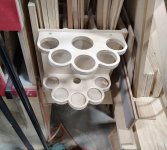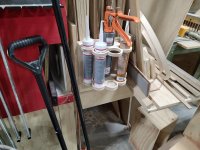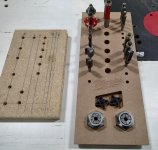Crazyraceguy
Member
- Joined
- Oct 16, 2015
- Messages
- 5,525
After watching one too many caulking tubes fall from his clamp rack, I decided to fix it. I designed an overly complex solution.
I have been told that everything I have done lately looks like brass knuckles.....only if you have too many fingers.
While I was doing this, he asked me if I could make him something better for his router bits. His brand preference is Milwaukee, so it had to fit in the drawer of a Packout.
This was all done "on the spot" strictly on-tool, no computer. Oh, except for the logo, I downloaded that months ago.
I have been told that everything I have done lately looks like brass knuckles.....only if you have too many fingers.
While I was doing this, he asked me if I could make him something better for his router bits. His brand preference is Milwaukee, so it had to fit in the drawer of a Packout.
This was all done "on the spot" strictly on-tool, no computer. Oh, except for the logo, I downloaded that months ago.



